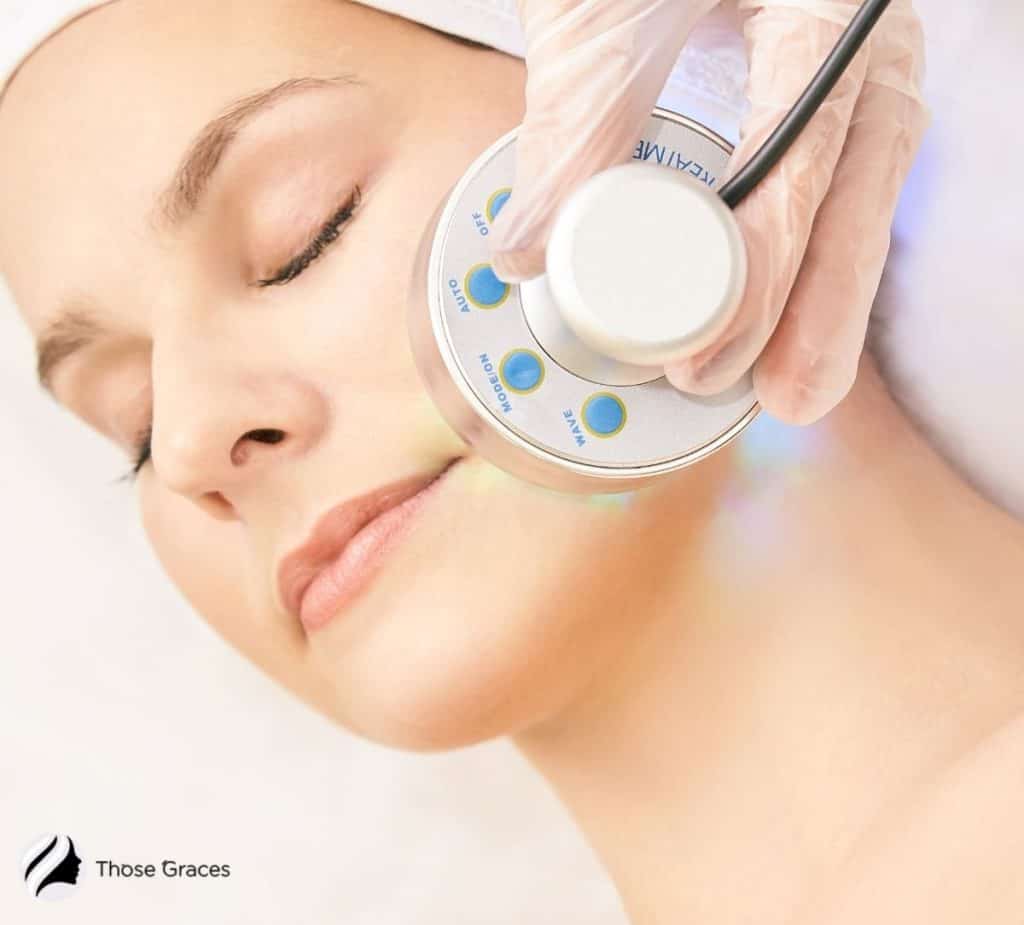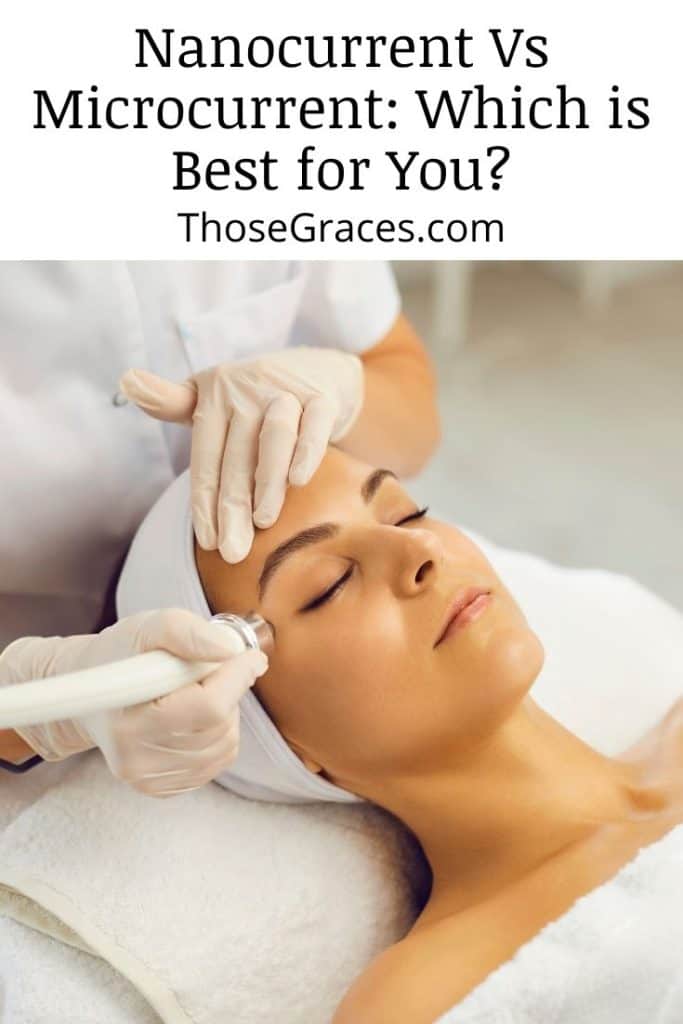Both of these treatments have been shown to be effective in reducing the signs of aging. You may be wondering what is the difference between nanocurrent vs microcurrent treatments.
As a skincare aficionado, I’ll show you. Here’s a look at how nanocurrent and microcurrent differ, and which one might be right for you. Read more to find out!
Table of Contents
What is Microcurrent & How Does it Work

Microcurrent is a non-invasive facelift that stimulates facial muscles with a low-level current of electricity, similar to an “exercise” for the face.
According to a study [1] by Potlwaski and Watson in 2009, microcurrent treatments, like a microcurrent device, have been clinically proven to be a safe and effective treatment for encouraging definition, developing collagen production.
This also stimulates ATP (Adenosine triphosphate — an energy-carrying molecule found in all living things) growth in skin cells both in clinics and at home.
READ MORE: ZIIP Vs NuFACE: Which is the Best?
Professional Treatments for Decades
The benefits of microcurrent [2] have been used for decades, particularly in physical treatment, explains Svendsen Graceanne Svendsen LE CME, a licensed aesthetician at Shafer Plastic Surgery and Laser Center. It is incredibly safe and effective, and it targets skin treatments since the 1970s.
Physical therapists have employed microcurrent therapy to treat pain, improve skin health, skin texture, skin tone and even facial paralysis conditions, like Bell’s palsy.
Microcurrent Facial: a Non-Painful Treatment
Svendsen, a skin professional, also states that the treatment doesn’t hurt (thank God, I was worried!) and just feels alive.
Although to be specific, she said there will only be a mild, zingy feeling — and the current will occasionally leap near the nerve linked to the muscle.
Here’s a video of how a microcurrent facial treatment works!
Most patients enjoy the sensation because it assures them that something is occurring and that a link has been established!
Make sure to check our microcurrent device reviews!
What is Nanocurrent & How Does it Work
The Nanocurrent Technology
Nanocurrents’ “intelligent energy” works by talking with your skin cells and prompting them to produce more collagen and elastin, the proteins that give your skin its strength and suppleness.
It can also be used to enhance circulation, reduce the appearance of acne and repair wounds and tissue for more healthy skin since it speeds up the skin’s natural regeneration process.
Here are some devices that use nanocurrent for treatment.
Rejuvenating Different Skin Types to a Whole New Level
Nanocurrent [4] enhances the molecule Adenosine Triphosphate (ATP) when it comes to touch with the skin.
ATP acts as the body’s energy “batteries,” storing and transporting chemical energy throughout the body while also supplying energy to your skin cells for reproduction and repair.
However, as we become older, our ATP levels drop. Nanocurrent boosts the creation of ATP, enabling your cells to interact and repair themselves while also replenishing their stored energy. This results in skin that is healthy-looking, elevated, and radiant.
What Are The Key Differences Between Microcurrent & Nanocurrent
If you are wondering what are the key differences between microcurrent and nanocurrent, here’s the gist.
Nanocurrent is used to reestablish a tight appearance on our faces and bodies by stimulating the production of collagen formation through an electric current.
It accomplishes this by safely reacting with important skin cells and tissues to generate kinetic heat, which encourages the skin to organically generate new collagen fibers and more of the skin’s natural plumping and moisturizing ingredient, hyaluronic acid.
Microcurrent, on the other hand, focuses on exercising the muscle tone beneath the skin, enabling them to strengthen while also improving cellular metabolism.
So you can understand clearly, I prepared a table below highlighting their key differences.
Key Differences
| Microcurrent | Nanocurrent | |
| Which is more painful? | While some of the more intensive treatments for microcurrent can be unpleasant, none of them create an unpleasant environment, and the most advanced microcurrent tools rarely cause downtime that interferes with work or daily activities. | Some of the treatments for nanocurrent can be pleasant since radiofrequency waves contain small electric currents that create heat. |
| Which lasts longer? | Microcurrent has a tendency to produce short-term benefits, and sessions must be repeated frequently. | While the immediate lifting and plumping effects of nanocurrent treatments are noticeable, the true results come from the new collagen and skin cells that are stimulated, resulting in a long-lasting, natural-looking result. |
| Which is more effective at reversing the effects of aging? | Microcurrent treatments are more commonly used as a preventative step for people who want to slow down the natural look of aging on their skin. | Nano current devices are used to repair and rejuvenate skin, making it tighter, firmer and plumper and assisting in the removal of wrinkles. |
| Overall care target | Microcurrent treatments are generally used to target facial muscles. | Nanocurrent has a multi-faceted application in that it can delicately stimulate the deeper layers of the skin to stimulate new collagen production. |
Jenny Scragg, a skin expert, said that some of the treatments can feel like a pleasant hot stone massage since radiofrequency waves contain small electric currents that create heat.
Here’s a video on what to expect when undergoing a radiofrequency waves treatment.
ALSO READ: Radio Frequency vs Microcurrent
Nanocurrent vs Microcurrent: What Should I Choose?
Professionals use both to achieve a clearer complexion, but you may ask what should you choose nanocurrent or microcurrent?
Microcurrent is used to tighten muscles, improve cellular metabolism and exercise the skin, while nanocurrent devices are used to repair and rejuvenate the skin.
Both are made up of electronic signals that are delivered with tiny needles attached to a machine, which stimulates the production of collagen formation through an electric current.
However, nanocurrent is a newer technology used to repair and rejuvenate the skin using radiofrequency waves that stimulate collagen formation.
Both microcurrent and nanocurrent result in visible improvement, but it comes down to your personal preference as well as which one meets your needs best.
Is Microcurrent Better than Nanocurrent?
There is no definite answer about microcurrent or nanocurrent being better.
But, If I am to summarize all the things I said here, ultimately, the effects of nanocurrent are long-lasting, but microcurrent provides instant lifting and sculpting.
On a cellular level, however, this powerful mix of both treatments helps create relevant changes in your skin! So, they both work wonders!
FAQs
Is Galvanic better than microcurrent?
What does galvanic current feel like?
Why is the current at a higher frequency in the galvanic current?
Conclusion
Nanocurrent and microcurrent can improve your skin tone, reduce wrinkles and smooth your fine lines.
You may experience minor discomfort during these procedures, but they are both considered safe. So, choose anything that you like best!
You will be happy with the results either way! Just don’t forget to stop by our site for more information on skin treatment!

Do you prefer Nanocurrent or Microcurrent? Let us know below!
References
- 1. Potalwski L, Watson T. (PDF) Bioelectricity and microcurrent therapy for tissue healing-a narrative review [Internet]. ResearchGate. 2009. Available from: https://www.researchgate.net/publication/233715126_Bioelectricity_and_microcurrent_therapy_for_tissue_healing-a_narrative_review
- 2. Shiffer E. Microcurrent Facial: How It Works, Professional vs. At-Home, Costs & More [Internet]. Cobb C, editor. Healthline. 2019. Available from: https://www.healthline.com/health/beauty-skin-care/microcurrent-facial#TOC_TITLE_HDR_1
- 3. Cosgrove BD, Gilbert PM, Porpiglia E, Mourkioti F, Lee SP, Corbel SY, et al. Rejuvenation of the muscle stem cell population restores strength to injured aged muscles. Nature Medicine. 2014;20:255–64.
- 4. Gabi M, Bullen ME, Agarkova I, Schmidt D, Schoenauer R, Brokopp C, et al. Effects of small pulsed nanocurrents on cell viability in vitro and in vivo: implications for biomedical electrodes. Biomaterials [Internet]. 2010 [cited 2022 Feb 18];31:8666–73. Available from: https://pubmed.ncbi.nlm.nih.gov/20800892/


